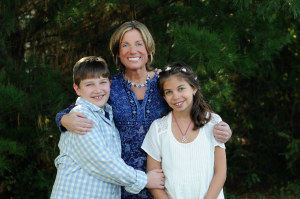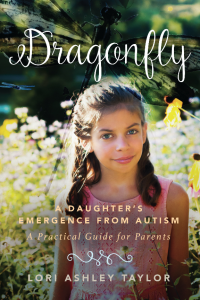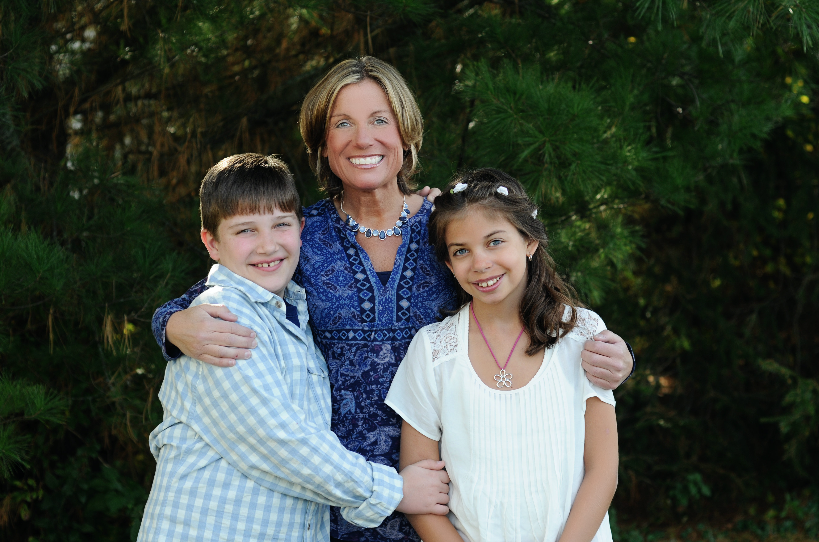Mom, Teacher & Advocate Writes Memoir Guidebook About Daughter’s Emergence from Autism
Writer / Christy Heitger-Ewing
Photography provided by Loree Alyane Photography
Twelve years ago, Lori Taylor walked into a bookstore in search of answers, hope and clarity. Her 2-year-old daughter, Hannah, had recently been diagnosed with autism and Taylor was trying to come to grips with what that diagnosis meant.
“I was looking for a story that followed what our family was going through,” says Taylor, eager to find a memoir that would help her navigate life going forward. Few books on the subject existed, and those that did were either fiction or centered on boys.
 So, Taylor, a sixth-grade math and science teacher at Avon Intermediate School West, did her own research and got her daughter into occupational, speech, developmental and physical therapies. She also enrolled Hannah in equine therapy, water therapy — anything and everything she could think of to help make her better.
So, Taylor, a sixth-grade math and science teacher at Avon Intermediate School West, did her own research and got her daughter into occupational, speech, developmental and physical therapies. She also enrolled Hannah in equine therapy, water therapy — anything and everything she could think of to help make her better.
“I wanted to save her,” says Taylor, who came to learn that her daughter didn’t need saving. “When I was telling Hannah to be or act a certain way, I was trying to fit a square peg into a round hole. She has autism and she always will. She’s hardwired to be who she’s going to be. And in the end, I love my daughter just the way she is.”
Taylor’s new perspective enabled her to appreciate the qualities in her daughter that once embarrassed her. For example, Hannah tends to blurt out whatever is on her mind. One day, they were at Walmart and Hannah told an overweight man with a receding hairline that he looked like the chicken guy from “Toy Story 2.” Although the incident was mortifying, at times Hannah’s bluntness is refreshing — even empowering. For instance, last summer Taylor and her daughter were attending an autism conference in Milwaukee when a participant raised her hand and shared that though her son had been diagnosed with autism, he didn’t look like he had autism.
Hannah stood up, turned around, and stated candidly, “Autism doesn’t have a look.”
Hannah, who was diagnosed at 18 months, had all the signs of classic autism. As a baby, rice cereal mashed potatoes, mac-n-cheese and applesauce were her staples, but if any of these foods touched her skin, she would scream bloody murder. She also struggled to transition to finger foods and only tolerated being held for five minutes at a time.
“She was my first baby. I thought it was normal for her to want to stay in her bouncy seat all day,” Taylor says. If Hannah’s name was called, she wouldn’t turn her head. Her wave was also different. Plus, she didn’t talk until she was four years old.
 “There were so many signs of autism, but I didn’t see them,” says Taylor, who had a revelation several years ago when she was at church. The minister posed the following question in his New Year’s Eve sermon: “What are you going to do this year with what you’ve got?”
“There were so many signs of autism, but I didn’t see them,” says Taylor, who had a revelation several years ago when she was at church. The minister posed the following question in his New Year’s Eve sermon: “What are you going to do this year with what you’ve got?”
Something about that question resonated with Taylor and she got to thinking about all of the research and note-taking she had done through the years regarding autism, not to mention the stories she’d collected from friends in the autism community.
“I’ve got all these resources that could potentially help others,” Taylor thought. “What if I put them together to make a book?”
Though the book-writing process was both brutal and bittersweet, Taylor hopes the end result will provide other families with awareness, acceptance and hope. Her newly published book “Dragonfly: A Daughter’s Emergence from Autism — A Practical Guide for Parents,” is a hybrid between a memoir and guidebook. It includes early signs and worries, intervention techniques and best practices, as well as insight from five parents, all respected members of Hendricks County who have children with autism. “Dragonfly” spells out the hallmarks of autism (e.g., communication delay, lack of two-way communication and perseverated interests) so that parents can intervene earlier when the brain is more pliable.
Taylor knows firsthand how difficult it is to initially accept that your child is different.
“I believe in the beginning, we all believe we’re going to raise the quarterback of the football team, the front row hitter in volleyball or the valedictorian,” Taylor says. “I would wake my husband up in the middle of the night, mourning Hannah never walking down the aisle or attending IU.”
Slowly Taylor came to grips that life was different — even on occasions when she tried to pretend that it wasn’t. On Hannah’s fourth birthday, the family took Hannah to Chuck E. Cheese’s so that she could fit in with her peers. The moment Hannah stepped inside the high-energy establishment and got her hand stamped, she repeatedly screeched, “It hurts! It hurts!”
“Her eyes were as big as arcade tokens,” Taylor says. It was sensory overload.
Hannah, now 13, is a piano player, artist and avid animal lover — particularly cats. In fact, she volunteers on Sundays at the humane society. She has a younger brother named Connor (10), who is included in the book in a chapter about siblings.
“It’s been challenging for him as through the years he’s had to go to a lot of OT, PT and feeding appointments,” Taylor says. “I’ve had to make sure I’m providing him with plenty of support all his own so that he feels like his own person.”
A behavior specialist (whom Hannah calls her “life coach”) comes to the house twice a week to help her understand figurative language.
“She has a hard time catching on to what others are saying when it comes to receptive and expressive language,” Taylor says. In addition, tactile experience and occupational therapy have helped Hannah make great strides. For example, there was a time that she wouldn’t tolerate being touched. Now she’s okay with hugging.
The book got its name from the fact that Hannah likens her own physical and cognitive journey with that of a dragonfly, which can live up to the first four years of its life underwater.
“Hannah was in an inaccessible world for the first four years of her life,” Taylor says. “Then, when she emerged, she had to learn how to fly. And, is still learning.”
Thankfully, autism awareness has grown substantially over the past decade, which means when people hear the word “autism” they don’t automatically think of the character from the movie “Rain Man.” Taylor, who has taught in the Avon schools for 23 years, is the founder and publisher of the blog “Emerging from Autism” and a member of Avon School Corporation’s Autism Team. She says the most joyful part of being Hannah’s mother is bearing witness to her brave and resilient spirit.
“She owns who she is,” Taylor says. “And that’s beautiful.”
“Dragonfly” is available for purchase through Amazon, Barnes & Noble and Target. The book can also be found on Skyhorse Publishing’s website. Taylor will be signing books at Barnes & Noble on April 7 from 1-4 p.m.






